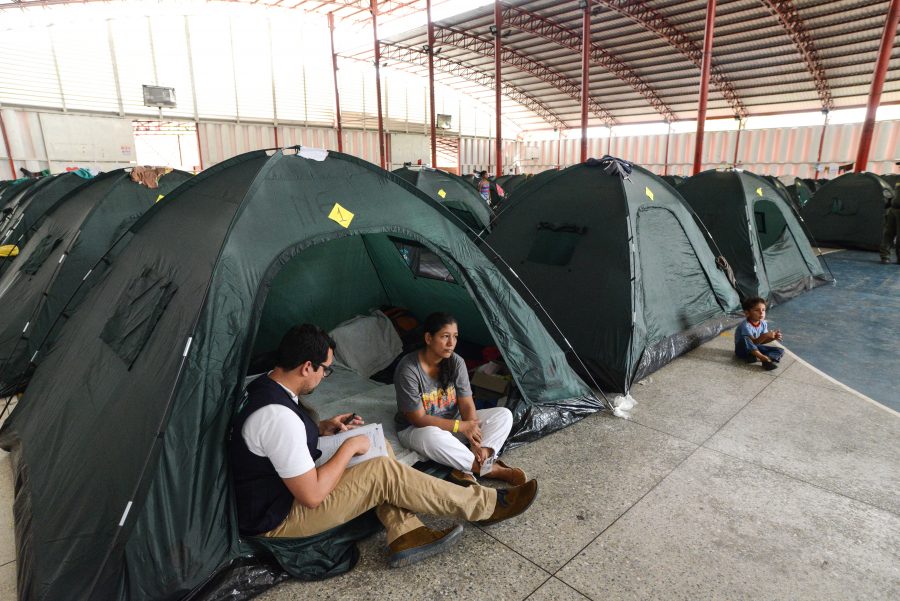 Video
Video
Last updated:
Africa and Middle East Food Crisis
 Video
Video
Current famine and near-famine situations exist in South Sudan, Yemen, Somalia, and northern Nigeria.
All four countries are conflict-affected and the scale of these emergencies has grown to unprecedented highs while much of the world has watched other disasters and complex humanitarian crises grab headlines. More than 20 million people across the region are at risk of starvation. While many countries worldwide face food security crises, only rarely do the conditions meet the formal criteria for a famine. The United Nations defines famine when certain measures of mortality, malnutrition and hunger are present. Those measures are: at least 20 percent of households in an area face extreme food shortages with limited ability to cope; acute malnutrition rates exceed 30 percent; and the death rate exceeds two persons per day per 10,000 persons.
Sources: Food and Agriculture Organization, World Food Program, OCHA, responding NGOs, CNN News, IRIN News and other news and agriculture reports.
Facts & stats
- More than 20 million people across the region are at risk of starvation.
- The United Nations uses a five-phase scale called the Integrated Food Security Phase Classification assessment to determine a country’s food security status.
- Famine often results from a failure of food production, access to food and humanitarian response. Those failures are caused by natural factors such as drought or man-made factors such as conflict.
Northern Nigeria
Conflict with Boko Haram has created massive displacement in Nigeria. As government forces work through areas previously dominated by Boko Haram, it’s anticipated that humanitarian responders will find pockets of people in areas previously cut off that are severely malnourished. Boko Haram destroyed much of the area’s infrastructure and because of displacement and conflict, crops have gone unplanted in some places for three years. If nothing changes, approximately 200 children will begin dying each day from food or medical needs.
Somalia
Somalia is currently experiencing its worst drought in 20 years, with 5.5 million people in need of some form of humanitarian assistance. Due to the drought, Somalia is also facing a critical cholera outbreak – more than 17,000 cases and 400 deaths so far this year (more than all of 2017). The security of aid workers in Somalia is also a high concern: last year there were 165 violent incidents and the presence of al-Shabab prevents their access to some areas.
South Sudan
More than 2,000 people are fleeing South Sudan daily to escape war and hunger. At least 4.9 people are food insecure, and the South Sudan government has declared formal famine in two counties. One of the largest problems here remains the large network of warring parties, all of whom have engaged in rampant sexual assaults against citizens and aid workers, in addition to killing and attacking aid workers bringing food and medicine into the country.
Yemen
Two-thirds of the country’s population does not have enough food to survive. Without a significant improvement in the food security situation, 6.8 million people are in danger of falling into famine. At least 17 million are already in need of life-saving nutrition assistance. The economy is shattered, leaving families unable to obtain cash to get food when it’s available on the open market. Getting food into the country is difficult, with commercial flights banned, and its main port severely damaged from airstrikes. Health services are severely weakened by the ongoing conflict and health centers are under-supplied. Cholera, measles, malaria and other diseases are present and treatment is difficult to access due to conflict, infrastructure damage, and difficulty bringing supplies into the country.
Learn more
- Four Famines: CDP’s webinar on the hunger crises
- We Are Not The World
- Drought and War Heighten Threat of Not Just One Famine, But Four
- Washington Post: How It Got So Bad
- Michael Klosson, vice president of policy and humanitarian response at Save the Children, writes on The Risk of Starvation in East Africa
Resources

Famine
According to the United Nations’ definition, a “famine” has taken hold when: at least 20 percent of households in an area face extreme food shortages; more than two people in 10,000 are dying each day (from both lack of food and reduced immunity to disease); and more than 30 percent of the population is experiencing acute malnutrition.

Complex Humanitarian Emergencies
CHEs involve an acute emergency layered over ongoing instability. Multiple scenarios can cause CHEs, like the civil wars in Syria and Yemen, the man-made political crisis in Venezuela, or the conflict in Ukraine.

Nutrition
In the immediate wake of a natural disaster, feeding and sheltering are two of the major issues that are addressed immediately following evacuation or search and rescue operations. These are core elements of survival and are an important area for government and nongovernmental responders.